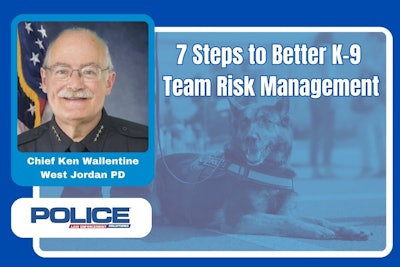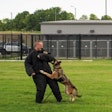 Ken Wallentine, chief of the West Jordan (Utah) Police Department, former Chief of Law Enforcement for the Utah Attorney General, and author of the “K9 Officer's Legal Handbook,” shares how to manage risk and liability for K-9 teams.Canva/Ken Wallentine/POLICE Illustration
Ken Wallentine, chief of the West Jordan (Utah) Police Department, former Chief of Law Enforcement for the Utah Attorney General, and author of the “K9 Officer's Legal Handbook,” shares how to manage risk and liability for K-9 teams.Canva/Ken Wallentine/POLICE Illustration
Dog bite incidents involving police K-9s can lead to complex legal and expensive outcomes, as highlighted by a recent settlement between Circleville, Ohio, city officials and a truck driver bitten by a police dog.
The city of Circleville has agreed to pay Jadarrius Rose $225,000 after he was bitten by a police K-9. Rose was bitten when he failed to surrender to police in an incident on July 4, 2023.
Such cases underscore the need for clear protocols and measures to address K-9 use-of-force incidents. Chief Ken Wallentine of the West Jordan (Utah) Police Department and former Chief of Law Enforcement for the Utah Attorney General shares steps departments can take to prevent and appropriately handle dog bite incidents, ensuring both public safety and accountability in these situations.
Wallentine has been a law enforcement officer for 42 years and was a K-9 handler for four of them. The author of the “K9 Officer's Legal Handbook,” stresses departments cannot remove liability completely with a police service dog, but there are 7 measures they can take to decrease their risk.
1. Look for Early Settlement Opportunities
“One thing that influences litigation is how we handle the lawsuits that come our way,” Wallentine says. “We want to circle the wagons and say, ‘There is no way we did anything wrong.’ But sometimes a quick settlement and apology can be all it takes to avoid a lawsuit.”
Wallentine shares a story when a police K-9 at his department bit a woman at a local dance years ago. The woman tried to pet the dog on his nose after being warned not to approach him. “To a dog that looks like you’re trying to cover its nose and eyes, and that is very threatening,” he says. “The dog nipped her on the wrist and tore her blouse.”
Though the woman initially acknowledged the bite as her fault, a few hours later she blamed the dog. The department dispatched a supervisor to the hospital where she was being treated for minor injuries and paid for her medical care. The next day a department member took her shopping to replace the damaged blouse. Because of their actions, the department resolved the situation without litigation.
“Look for early settlement of a claim and be very proactive,” Wallentine advises. “Don’t wait for someone to file a claim. Go to them and say, ‘I know you were hurt. We are going to take care of your medical bills and give you a little bit for the inconvenience. In return, we ask that you sign this release.’”
2. Be Use-of-Force Experts
“K-9 handlers ought to be the absolute use-of-force experts in the department,” Wallentine says. “Other officers have batons, pepper spray, TASERs and guns, but if you look at the frequency in which they use them [it’s far less than a police K-9]. We really ought to be training handlers more on how to decide when to use force.”
West Jordan PD provides use-of-force classroom training annually and offers use of force in-service training quarterly. The department also delivers daily training briefs through Lexipol Training Bulletins.
3. Provide Effective Supervision
A week ago, a city council member went on a ride along with a West Jordan PD K-9 team. During the ride-along, the handler dispatched the dog to apprehend a fleeing suspect. Later, Wallentine had the opportunity to explain the why of the incident to the city council member, a process made easier through effective supervision.
He explains that a first-line supervisor reviewed the bite incident that night. The next morning the review worked its way through command staff and within 48 hours it reached his desk. The reporting and subsequent reviews helped Wallentine explain the event to the questioning city council member.
“The best risk manager is the police sergeant on the road,” he says, explaining they should be charged with asking three questions with every incident:
- What can go wrong?
- How can we keep it from going wrong?
- When it goes wrong, and someone is harmed, what can we do to minimize the harm?
“It’s vital to get supervisors to see risk management as part of their job,” he says. “One thing I’ve found is reminding them that risk management helps protect the careers of the officers they are responsible for and their own careers.”
4. Properly Evaluate Use of Force
In Graham v. Connor, the U.S. Supreme Court determined an objective reasonableness standard should apply to a civilian's claim that law enforcement officials used excessive force in making an arrest, investigatory stop, or other "seizure" of his or her person.
According to Wallentine, a practicing attorney, this case sets appropriate benchmark for assessing use of force within K-9 teams. The questions to consider are:
- How serious was the crime?
- Was there an imminent threat to the officer or the public?
- What level of resistance was there?
“Your K-9 officers should be able to rattle these questions off the top of their heads,” he says. “Our officers are our best liability managers.”
5. Develop a Risk Management Culture
Develop a risk management culture, Wallentine advises. “Consider what you permit, what you tolerate, what you put up with and what you ignore,” he says. “Then work toward developing a culture that honors and recognizes behaviors that manage risk across the agency.”
This includes having clear, specific policies and procedures explaining K-9 operations. "These policies should be detailed, practical and written in understandable terms,” Wallentine says.
One area to focus on is demanding excellence in report writing, especially with K-9 officers, he says, recalling a bite incident where the Utah department was served with a lawsuit a year later.
“We were all scratching our heads trying to remember this arrest,” he says. “Fortunately, the officer had been well-trained and had written a significant ‘novel’ for the disorderly conduct arrest. We need to encourage K-9 officers to be the best report writers we have in the department.”
Teach K-9 officers what an excellent incident report looks like. Wallentine notes these reports should include:
Suspect behaviors. These are the things the suspect did to prompt the handler to send in the dog.
What the suspect did to resist, prior to the K-9 being sent in and when the dog bit them.
- Photographs of their injuries after the bite.
- Records of their medical treatment for the bite.
- Statements the suspect made about the bite, including those where they said the bite was their fault.
- The quantities of any drugs that were seized.
6. Give Ample Warning
Sometimes, no matter what is done, officers will need to deploy their K-9s. Here, agencies must prioritize audible warnings before deploying canines, affording subjects the opportunity to surrender peacefully, Wallentine says.
Warnings also should be communicated in languages understood by the suspect, Wallentine stresses. “We do everything bilingually,” he says. “A quarter of my residents speak Spanish. We also give clear warnings and repeat them. Our warnings are explicit, ‘Cooperate. Surrender. Make yourself known. To avoid being bitten.’”
He explains courts will consider the clock to determine if warnings were clear and if the officer gave the suspect sufficient time to respond.
Wallentine acknowledges that sometimes warnings are not tactically appropriate. If an officer must send in a dog to locate a hidden suspect, a warning may not always be possible or heard. “We can give the warning, but we have no way of knowing for sure if the suspect is in there, if they can hear us, and what is a reasonable opportunity for them to comply,” he says.
7. Train and Train Often
“Require performance training, which includes decision-making training,” Wallentine says, recommending a minimum of 16 to 20 hours a month.
He explains the industry standard is four hours per week, per profile. This means if an agency has a dual-profile dog, for example, one trained to detect substances and electronic media, that dog requires eight hours of training per week. Eight hours per week is the standard in this agency, according to Wallentine.
Wallentine adds keeping training and certification records is also critical. “If there is a significant case, there will be a challenge to the dog’s reliability and training,” he says. “I recommend keeping at least two years of training and certification records for each K-9 team. We use K9 Activity Tracking System Law Enforcement Software (KATS) for that purpose.”
KATS, he says, prompts officers to answer questions about each training session, creating a record of what they trained on, the weather, operational conditions and more. “You want to train dogs in as many environments as you can,” he adds, “and keep records of each training event.”
Dog bite incidents involving law enforcement K-9s can cause significant legal and financial ramifications. When agencies foster a culture of excellence and accountability, Wallentine says they can navigate police K-9 bite incidents with greater transparency, professionalism, and adherence to legal standards.



















